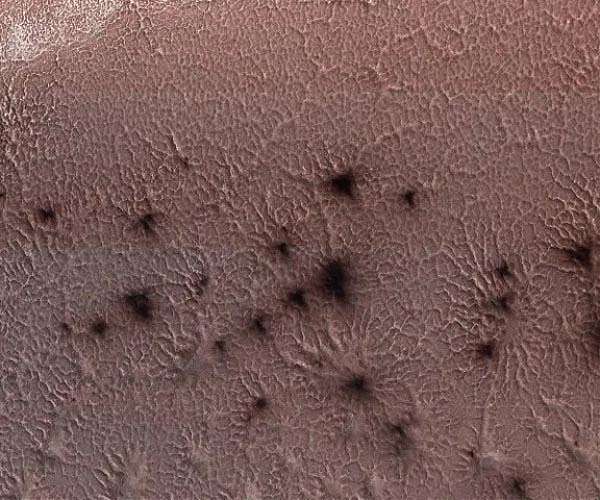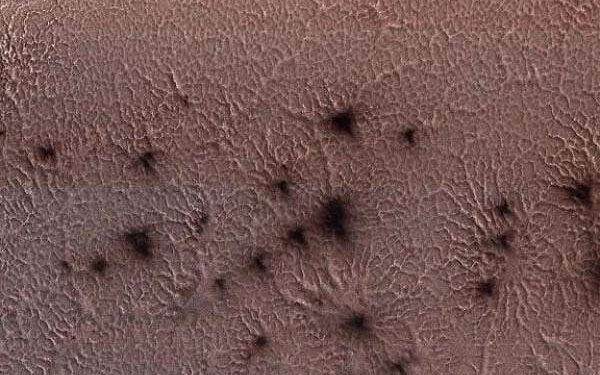
Are there living microbes on Mars? Check the ice
by Mariah Lucas for Penn News
University Park PA (SPX) Oct 17, 2025
Frozen in time, ancient microbes or their remains could be found in Martian ice deposits during future missions to the Red Planet. By recreating Mars-like conditions in the lab, a team of researchers from NASA Goddard Space Flight Center and Penn State demonstrated that fragments of the molecules that make up proteins in E. coli bacteria, if present in Mars’ permafrost and ice caps, could remain intact for over 50 million years, despite harsh and continuous exposure to cosmic radiation. In the study, published in Astrobiology, the researchers encouraged future missions searching for life on Mars to target locations with pure ice or ice-dominated permafrost for exploration, as opposed to studying rocks, clay or soil.
“Fifty million years is far greater than the expected age for some current surface ice deposits on Mars, which are often less than two million years old, meaning any organic life present within the ice would be preserved,” said co-author Christopher House, professor of geosciences, affiliate of the Huck Institutes of the Life Sciences and the Earth and Environment Systems Institute, and director of the Penn State Consortium for Planetary and Exoplanetary Science and Technology. “That means if there are bacteria near the surface of Mars, future missions can find it.”
The research team, led by corresponding author Alexander Pavlov, a space scientist at NASA Goddard – who completed a doctorate in geosciences at Penn State in 2001 – suspended and sealed E. coli bacteria in test tubes containing solutions of pure water ice. Other E. coli samples were mixed with water and ingredients found in Mars sediment, like silicate-based rocks and clay.
The researchers froze the samples and transferred them to a gamma radiation chamber at Penn State’s Radiation Science and Engineering Center, which was cooled to minus 60 degrees Fahrenheit, the temperature of icy regions on Mars. Then, the samples were blasted with radiation equivalent to 20 million years of cosmic ray exposure on Mars’ surface, vacuum sealed and transported back to NASA Goddard under cold conditions for amino acid analysis. Researchers modelled an additional 30 years of radiation for a total 50-million-year timespan.
In pure water ice, more than 10% of the amino acids – the molecular building blocks of proteins – from the E. coli sample survived the simulated 50-million-year timespan, while the samples containing Mars-like sediment degraded 10 times faster and did not survive. A 2022 study by the same group of researchers at NASA found that amino acids preserved in a 10% water ice and 90% Martian soil mixture were destroyed more rapidly than samples containing only sediment.
“Based on the 2022 study findings, it was thought that organic material in ice or water alone would be destroyed even more rapidly than the 10% water mixture,” Pavlov said. “So, it was surprising to find that the organic materials placed in water ice alone are destroyed at a much slower rate than the samples containing water and soil.”
That degradation could be due to a slippery film that forms in areas where ice touches minerals, the researchers hypothesized, allowing radiation to reach and destroy amino acids.
“While in solid ice, harmful particles created by radiation get frozen in place and may not be able to reach organic compounds,” Pavlov said. “These results suggest that pure ice or ice-dominated regions are an ideal place to look for recent biological material on Mars.”
In addition to testing for conditions on Mars, researchers also tested organic material in temperatures similar to those on Europa, an icy moon of Jupiter, and Enceladus, an icy moon of Saturn. They found that these even colder temperatures further reduced the rate of deterioration.
Those results are encouraging to NASA’s Europa Clipper mission, Pavlov said, which will explore the ice shell and ocean of Europa, the fourth largest of Jupiter’s of 95 moons. Europa Clipper launched in 2024 and is traveling 1.8 billion miles to reach Jupiter in 2030. It will conduct 49 close flybys of Europa to assess whether there are places below the surface that could support life.
For exploring ice on Mars, the 2008 NASA Mars Phoenix mission was the first to excavate down and capture photos of ice in the Mars equivalent of the Arctic Circle.
“There is a lot of ice on Mars, but most of it is just below the surface,” House said. “Future missions need a large enough drill or a powerful scoop to access it, similar to the design and capabilities of Phoenix.”
In addition to House and Pavlov, the co-authors include Zhidan Zhang, a retired lab technologist in the Penn State Department of Geosciences; and Hannah McLain, Kendra Farnsworth, Daniel Glavin, Jamie Elsila and Jason Dworkin, all researchers at NASA Goddard.
NASA’s Planetary Science Division Internal Scientist Funding Program through the Fundamental Laboratory Research work package at Goddard Space Flight Center supported this research.
Research Report:Slow Radiolysis of Amino Acids in Mars-Like Permafrost Conditions: Applications to the Search for Extant Life on Mars
Related Links
Penn State Consortium for Planetary and Exoplanetary Science and Technology
Mars News and Information at MarsDaily.com
Lunar Dreams and more
